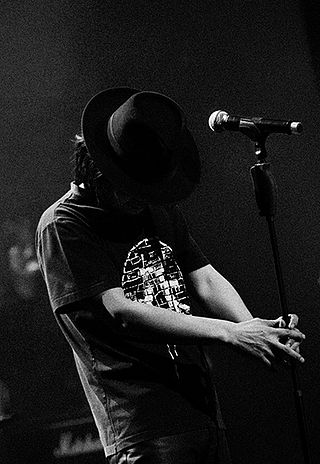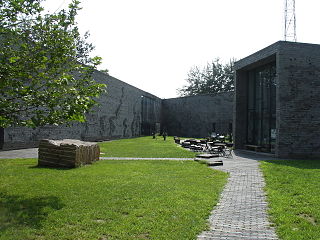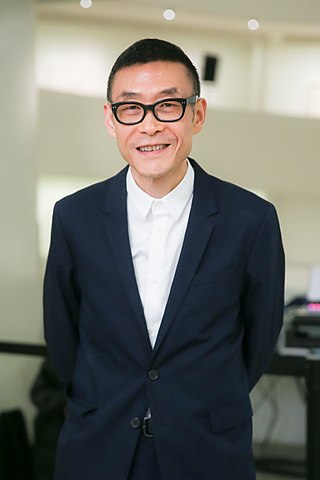Related Research Articles
Qiu Zhijie is a contemporary Chinese artist who works primarily in video and photography. Overall, Qiu's work suggests the struggle between the forces of destiny and self-assertion. Other common themes are social fragmentation and transience.
Shi Jinsong is a Chinese artist based in Wuhan and Beijing. He studied at Hubei Institute of Fine Arts in China where he majored in sculpture and mastered an array of traditional styles and techniques. He graduated in 1994.
Yishu: Journal of Contemporary Chinese Art is the first English-language journal specializing in Chinese art and culture. Each bi-monthly issue features scholarly essays on topical issues, interviews with artists and curators, conference proceedings, and critical commentary on exhibitions and books.
Tang Contemporary Art Gallery is a commercial art gallery with branches in China, Hong Kong and Thailand.
Beijing Commune is a China-based gallery, mainly featuring emerging artists' exhibitions.

Pékin Fine Arts, is a contemporary art gallery in Beijing established in 2005, with a Hong Kong branch gallery opened in 2012. It was listed by The New York Times as one of the "top museums and galleries" in Beijing, and listed by Forbes as one of the ten galleries in Beijing from which to buy Chinese art.
Lü Shengzhong is a Chinese artist who specializes in the ancient Chinese art of paper cutting. He came of age during the turbulent Cultural RevoLütion. When China started to open up following the death of Chairman Mao in 1976, Lü Shengzhong turned to traditional Chinese folk arts, unlike his contemporaries who embraced contemporary art forms practiced in the West, such as installation art, oil paintings and performance art. Lü remarked, "I walked away from the cultural confusion of the time and turned back to traditional folk art."
Caochangdi was an urban village and renowned arts district located in the Chaoyang District of northeast Beijing at the intersection of the 5th Ring Road and Airport Expressway. Translated as "grasslands" in Mandarin, Caochangdi was home to a diverse group of residents, including migrant workers, farmers, students and artists, most notably, Ai Weiwei. Caochangdi developed into a thriving arts and cultural hub when artists began to move into the area around 2000, attracting international attention similar to the nearby 798 Art Zone. Demolition of the village began in July 2018.

Zuoxiao Zuzhou, real name Wu Hongjin, (吴红巾), is a Chinese musician and artist.
Jean-Marc Decrop is a specialist of Chinese contemporary art. He is one among the art collectors who have contributed to the discovery, the recognition and the influence of Chinese contemporary art abroad.

Three Shadows Photography Art Centre, is a non-profit art centre in Beijing established in 2007 by photographers RongRong and inri. Three Shadows is the first contemporary art space dedicated exclusively to photography and other lens-based art in China. A converted auto repair yard, the 4,600 square meter complex includes 880 square meters of gallery space and was designed by renowned artist and architect Ai Weiwei. Three Shadows is situated in the art district of Caochangdi, on the outskirts of Beijing.
Fabien Fryns is a Belgian art dealer and collector, residing in Beijing since 2004. He has worked in the art world since 1986, specializing in contemporary Chinese art since 2000.

UCCA Center for Contemporary Art or UCCA is a leading Chinese independent institution of contemporary art. Founded in 2007 and located at the heart of the 798 Art District in Beijing, China, it welcomes more than one million visitors a year. Originally known as the Ullens Center for Contemporary Art, UCCA underwent a major restructuring in 2017 and now operates as the UCCA Group, comprising two distinct entities: UCCA Foundation, a registered non-profit that organizes exhibitions and research, stages public programs, and undertakes community outreach; and UCCA Enterprises, a family of art-driven retail and educational ventures. In 2018, UCCA opened an additional museum, UCCA Dune, in Beidaihe, a seaside resort town close to Beijing. In 2021, a third site in Shanghai was opened, UCCA Edge. The museum had 385,295 visitors in 2020, and ranked 55th in the List of most-visited art museums in the world.

Yuan Gong, is a Chinese contemporary artist. He has obtained a PhD degree in theory of art at the Chinese National Academy of Arts in 2012, but has immersed himself in different aspects of Chinese contemporary art since the 1990s. Being both creator and researcher, designer and planner, Yuan is a multiple facets artist playing at the interface of conceptual art, performance and fine arts. Using a large variety of media, his artworks address many philosophical questions, reflecting his concerns about the Chinese society and impugning the art system, the exhibition format and the status of the artwork.
HHF Architects is an architectural practice established in Basel, Switzerland by Tilo Herlach, Simon Hartmann, and Simon Frommenwiler, in 2003.
Ethan Cohen is an American collector and art dealer based in New York City who specialises in contemporary Chinese art and contemporary African art. He was one of the first western dealers to sell work by contemporary Japanese and Chinese artists including Ushio Shinohara and Ai Weiwei. He has been called "one of the most influential art dealers in the world". Forbes praised his gallery as an "exemplar in the field", putting on "resplendent, probing shows".

Wang Jianwei is a new media, performance, and installation artist based in Beijing, China.
China's New Art, Post-1989 was the first major collection of Chinese experimental art to exhibit outside the country. The exhibition took place between January 30 to February 28, 1993, as part of Hong Kong Arts Festival in Hong Kong City Hall and at Pao Galleries, Hong Kong Arts Centre. The touring exhibition travelled to Taipei, Melbourne, London, Vancouver, and various cities in the USA from 1993 to 1997.
Ho Sin Tung is a visual artist who lives and works in Hong Kong.
Inside/Out: New Chinese Art was an exhibition held 15 September 1998 to 3 January 1999 held in association with Asia Society and the San Francisco Museum of Modern Art. The exhibition was presented simultaneously at Asia Society in New York and P.S.1 Contemporary Art Center. It was curated by Gao Minglu and featured artists from mainland China, Taiwan and Hong Kong with artworks from the 1980s to 1990s.
References
- ↑ New York Observer Archived October 30, 2009, at the Wayback Machine
- ↑ New York Times
- ↑ Art in Asia history of Japanese, Korean and Chinese art at the Venice Biennale" Archived July 22, 2011, at the Wayback Machine "
- ↑ HHF Architects awards " "HHF Architects: HERLACH HARTMANN FROMMENWILER: News". Archived from the original on February 11, 2010. Retrieved December 19, 2009."
- ↑ HHF Architects ArtFarm project " "HHF Architects: HERLACH HARTMANN FROMMENWILER: Artfarm". Archived from the original on February 13, 2010. Retrieved December 19, 2009."